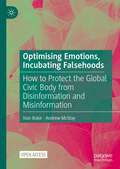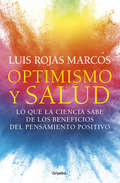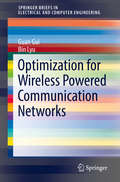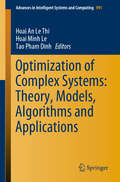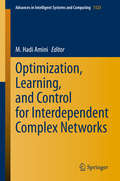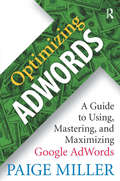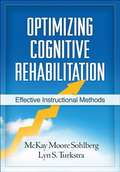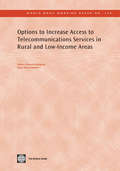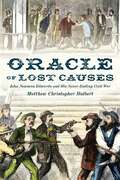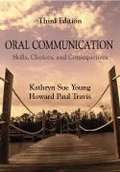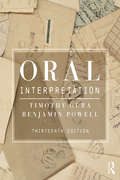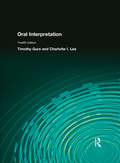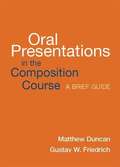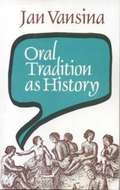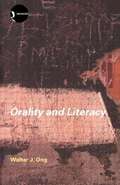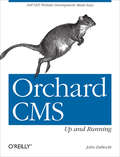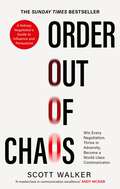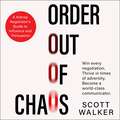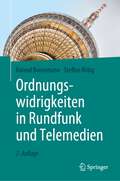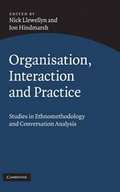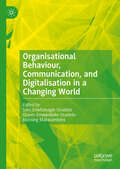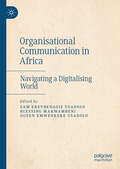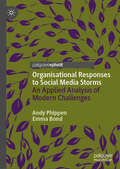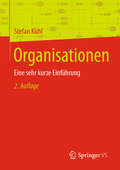- Table View
- List View
Optimising Emotions, Incubating Falsehoods: How to Protect the Global Civic Body from Disinformation and Misinformation
by Andrew McStay Vian BakirThis open access book deconstructs the core features of online misinformation and disinformation. It finds that the optimisation of emotions for commercial and political gain is a primary cause of false information online. The chapters distil societal harms, evaluate solutions, and consider what must be done to strengthen societies as new biometric forms of emotion profiling emerge. Based on a rich, empirical, and interdisciplinary literature that examines multiple countries, the book will be of interest to scholars and students of Communications, Journalism, Politics, Sociology, Science and Technology Studies, and Information Science, as well as global and local policymakers and ordinary citizens interested in how to prevent the spread of false information worldwide, both now and in the future.
Optimismo y salud: Lo que la ciencia sabe de los beneficios del pensamiento positivo
by Luis Rojas MarcosEn este nuevo libro del reconocido psiquiatra Luis Rojas Marcos, aprenderemos que sentir y pensar en positivo es una inversión sumamente rentable para desarrollar al máximo las posibilidades de vivir sanos y felices. Además de conocer los ingredientes que distinguen el optimismo del pesimismo, explorar las fuerzas que forjan nuestro temperamento e identificar los venenos más dañinos, el autor describe eficaces estrategias para fomentar el positivismo al tiempo que examina la influencia del optimismo en las relaciones con otras personas, así como en la salud y el trabajo. Un texto indispensable para el momento actual. «A lo largo de los años, tanto en mi vida personal como en el mundo de la medicina, la psiquiatría y la salud pública, he tenido oportunidad de confirmar, en incontables ocasiones, que la forma de percibir e interpretar las situaciones que nos plantea la vida ejerce un inmenso poder sobre nuestras emociones, decisiones, conductas y juicios. Para disfrutar de una vida saludable y completa, no basta con curar los males que nos aquejan; es igualmente importante conocer y fortificar los aspectos favorables de nuestra naturaleza, que nos ayudan a motivarnos, a superar los retos y a alcanzar nuestras metas.»LUIS ROJAS MARCOS
Optimization for Wireless Powered Communication Networks (SpringerBriefs in Electrical and Computer Engineering)
by Guan Gui Bin LyuThis SpringerBrief introduces the basics of wireless powered communication networks (WPCNs). In particular, the background and concept of WPCNs are briefly discussed. Moreover, this brief provides an extensive study of the recent developments in this area from an optimization perspective. Wireless powered communication network (WPCN) is a new network paradigm for IoT, where wireless devices (WDs) are powered by radio frequency (RF) based wireless power transfer (WPT) to eliminate the need for recharging or replacing the batteries manually and to prolong their lifetime.In this context, the brief also discusses some optimization problems for state-of-the-art scenarios of wireless powered communication networks.The target audiences for this SpringerBrief are researchers, engineers, and undergraduate and graduate-level students, who are studying or working in wireless powered communication networks and its performance optimization.
Optimization of Complex Systems: Theory, Models, Algorithms and Applications (Advances in Intelligent Systems and Computing #991)
by Hoai An Le Thi Hoai Minh Le Tao Pham DinhThis book contains 112 papers selected from about 250 submissions to the 6th World Congress on Global Optimization (WCGO 2019) which takes place on July 8–10, 2019 at University of Lorraine, Metz, France. The book covers both theoretical and algorithmic aspects of Nonconvex Optimization, as well as its applications to modeling and solving decision problems in various domains. It is composed of 10 parts, each of them deals with either the theory and/or methods in a branch of optimization such as Continuous optimization, DC Programming and DCA, Discrete optimization & Network optimization, Multiobjective programming, Optimization under uncertainty, or models and optimization methods in a specific application area including Data science, Economics & Finance, Energy & Water management, Engineering systems, Transportation, Logistics, Resource allocation & Production management. The researchers and practitioners working in Nonconvex Optimization and several application areas can find here many inspiring ideas and useful tools & techniques for their works.
Optimization, Learning, and Control for Interdependent Complex Networks (Advances in Intelligent Systems and Computing #1123)
by M. Hadi AminiThis book focuses on a wide range of optimization, learning, and control algorithms for interdependent complex networks and their role in smart cities operation, smart energy systems, and intelligent transportation networks. It paves the way for researchers working on optimization, learning, and control spread over the fields of computer science, operation research, electrical engineering, civil engineering, and system engineering. This book also covers optimization algorithms for large-scale problems from theoretical foundations to real-world applications, learning-based methods to enable intelligence in smart cities, and control techniques to deal with the optimal and robust operation of complex systems. It further introduces novel algorithms for data analytics in large-scale interdependent complex networks. • Specifies the importance of efficient theoretical optimization and learning methods in dealing with emerging problems in the context of interdependent networks • Provides a comprehensive investigation of advance data analytics and machine learning algorithms for large-scale complex networks • Presents basics and mathematical foundations needed to enable efficient decision making and intelligence in interdependent complex networks M. Hadi Amini is an Assistant Professor at the School of Computing and Information Sciences at Florida International University (FIU). He is also the founding director of Sustainability, Optimization, and Learning for InterDependent networks laboratory (solid lab). He received his Ph.D. and M.Sc. from Carnegie Mellon University in 2019 and 2015 respectively. He also holds a doctoral degree in Computer Science and Technology. Prior to that, he received M.Sc. from Tarbiat Modares University in 2013, and the B.Sc. from Sharif University of Technology in 2011.
Optimizing AdWords: A Guide to Using, Mastering, and Maximizing Google AdWords
by Paige MillerOptimizing AdWords provides the information marketers and future marketers need to harness the power of the Google’s AdWords search engine marketing applications. It provides a big picture overview of the AdWords system, helping businesses and individuals decide how to advertise products or their clients’ products. Optimizing AdWords was written for those at every rung of the ladder, from Marketing Directors to small business owners to students just starting out in marketing. This volume is organized around accessibility and ease of use. Author Paige Miller, co-founder of MultiPlanet Marketing Inc., has written this how-to guide to be super easy and fast to read and absorb. It moves you straight to the salient points of the text, allowing readers to take on AdWords in overview before coming back and collecting the finer details. Chapters 1 through 4 cover the basics, while the rest serve as a reference readers can come back to in building and growing campaigns. Using this book, professional marketers and other business professionals can utilize Google AdWords and optimize it for existing marketing strategies, or create whole new campaigns based around the system. Today, given the level of competition for ad positions on Google search pages, success hinges on understanding Google AdWords well enough to outperform competition. This book will provide readers with the knowledge necessary to master Google AdWords.
Optimizing Cognitive Rehabilitation
by Lyn Turkstra Mckay SohlbergRehabilitation professionals face a key challenge when working with clients with acquired cognitive impairments: how to teach new skills to individuals who have difficulty learning. Unique in its focus, this book presents evidence-based instructional methods specifically designed to help this population learn more efficiently. The expert authors show how to develop, implement, and evaluate an individualized training plan. They provide practical guidelines for teaching multistep procedures, cognitive strategies, the use of external aids, and more. User-friendly features include 17 sample worksheets and forms; blank forms can be downloaded and printed in a convenient 8 1/2" x 11" size.
Options to Increase Access to Telecommunications Services in Rural and Low-Income Areas
by Juan Navas-Sabater Arturo Muente-KunigamiTelecommunications sector policy-makers and regulators have a wide range of instruments available to them that can be used to increase access to telecommunications services in rural and low-income areas. The paper provides a review of these instruments, evaluating them against a set of criteria. It then goes on to identify a number of them that are worthy of further consideration by policy-makers and regulators while demonstrating that the effectiveness of the identified instruments can be greatly enhanced by the establishment of a conducive legal, regulatory and institutional framework. The paper concludes by confirming that while no single instrument taken in isolation can provide a full solution to universal access, a mix of the measures identified can be devised to achieve specific policy objectives in a particular country environment.
Oracle of Lost Causes: John Newman Edwards and His Never-Ending Civil War
by Matthew Christopher HulbertJohn Newman Edwards was a soldier, a father, a husband, and a noted author. He was also a virulent alcoholic, a duelist, a culture warrior, and a man perpetually at war with the modernizing world around him. From the sectional crisis of his boyhood and the battlefields of the western borderlands to the final days of the Second Mexican Empire and then back to a United States profoundly changed by the Civil War, Oracle of Lost Causes chronicles Edwards&’s lifelong quest to preserve a mythical version of the Old World—replete with aristocrats, knights, damsels, and slaves—in North America. This odyssey through nineteenth-century American politics and culture involved the likes of guerrilla chieftains William Clarke Quantrill and &“Bloody Bill&” Anderson, notorious outlaws Frank and Jesse James, Confederate general Joseph Orville Shelby, and even Emperor Maximilian I and Empress Charlotte of Mexico. It is the story of a man who experienced Confederate defeat not once but twice, and how he sought to shape and weaponize the memory of those grievous losses. Historian Matthew Christopher Hulbert ultimately reveals how the Civil War determined not only the future of the vast West but also the extent to which the conflict was part of a broader, international sequence of sociopolitical uprisings.
Oral Communication: Skills, Choices, and Consequences
by Kathryn Sue Young Howard Paul TravisThis book is designed to help you recognize the importance of your words and actions in communication. The goals for this undergraduate communication textbook are to: (1) engage you to think about the skills, choices, and consequences of your communication; (2) create a book you will want to read; and (3) convince you that success can be yours if you make solid choices in your communication style.
Oral Interpretation (Mysearchlab Series 15% Off Ser.)
by Benjamin Powell Timothy GuraIn its 13th Edition, the iconic Oral Interpretation continues to prepare students to analyze and perform literature through an accessible, step-by-step process. New selections join classic favorites, and chapters devoted to specific genres—narrative, poetry, group performance, and more—explore the unique challenges of each form. Now tighter and more focused than its predecessors, this edition highlights movements in contemporary culture—especially the contributions of social media to current communication. New writings offer advice and strategies for maximizing body and voice in performance, and enhanced devices guide novices in performance preparation.
Oral Interpretation (Mysearchlab Series 15% Off Ser.)
by Timothy Gura Charlotte LeeFor over fifty years, Oral Interpretation has successfully prepared students to analyze and perform literature through an accessible, step-by-step process. The authors classic commitment to helping students understand literature then to embody and evoke the work has been refined to offer students a more concise, user-friendly process that will help them succeed in their daunting first performance. Updated with a tightly edited collection of classic and contemporary selections, each chapter provides a wide variety of selections for students at all levels. Chapters devoted to each genre---narrative, poetry, drama, group performance–explore the unique challenges of each form while newly revised chapters on Using the Body and Using the Voice in performance introduce students to technical exercises to promote performance flexibility.
Oral Literary Performance in Africa: Beyond Text (Routledge African Studies)
by Nduka Otiono and Chiji AkọmaThis book delivers an admirably comprehensive and rigorous analysis of African oral literatures and performance. Gathering insights from distinguished scholars in the field, the book provides a range of contemporary interdisciplinary perspectives in the study of oral literature and its transformations in everyday life, fiction, poetry, popular culture, and postcolonial politics. Topics discussed include folklore and folklife; oral performance and masculinities; intermediated orality, modern transformations, and globalization; orality and mass media; spoken word and imaginative writing. The book also addresses research methodologies and the thematic and theoretical trajectories of scholars of African oral literatures, looking back to the trailblazing legacies of Ruth Finnegan, Harold Scheub, and Isidore Okpewho. Ambitious in scope and incisive in its analysis, this book will be of interest to students and scholars of African literatures and oral performance as well as to general readers interested in the dynamics of cultural production.
Oral Presentations in the Composition Course: A Brief Guide
by Matthew Duncan Gustav W. FriedrichThe ideal supplement for any writing class that includes an oral component, Oral Presentations in the Composition Course: A Brief Guide offers students the advice they need to plan, prepare, and present their work effectively. With sections on analyzing audiences, choosing effective language, using visual aids, collaborating on group presentations, and dealing with the fear of public speaking, this booklet offers help for students' most common challenges in developing oral presentations.
Oral Tradition as History
by Jan VansinaAlthough written by a leading historian of Africa, Vansina's work on oral traditions ranges far beyond Africa, so has a wider relevance. Vansina explains not only how oral traditions have been used in the past but also how they should be used by historians in their research.
Orality and Literacy: The Technologizing of the Word
by Walter J. OngThis classic work explores the vast differences between oral and literate cultures and offers a brilliantly lucid account of the intellectual, literary and social effects of writing, print and electronic technology.
Orchard CMS: ASP.NET Website Development Made Easy
by John ZablockiUse your C# skills to build your next website with Orchard, the popular content management system based on ASP.NET MVC. With step-by-step guidance, you’ll learn your way around the Orchard environment by constructing a complete, real-world site throughout the course of this book. You’ll create, manage, and display dynamic content with out-of-the-box functionality, and then build themes, modules, and widgets to customize the site.Author John Zablocki gets you started by showing you how to obtain and compile the Orchard source code, so you can more efficiently customize and manage the sites you create.Create or extend Orchard content types to manage dynamic contentUse alternate templates to change the way Orchard displays contentDesign a theme to define your website’s look and feelBuild custom modules when the Orchard Gallery doesn’t have extensions you needCreate reusable content pieces by creating widgetsExplore options for adding multi-language support to a siteLearn hosting options for your Orchard sites, including the cloudPackage your custom themes and modules to share in Orchard Gallery
Order Out of Chaos: A Kidnap Negotiator's Guide to Influence and Persuasion
by Scott WalkerA new approach to succeeding in negotiations where failure is not an option, from one of the world's most experienced kidnap for ransom negotiators.Scott Walker has probably one of the most difficult jobs in the world. When pirates have hijacked a ship, when a criminal gang has kidnapped someone, when an entire company's future is being held to ransom from a cyber-attack, Scott is the person who gets called in. He has successfully negotiated more than 300 such incidents using the principles in this book.His methods, centred in empathy, active listening, trust-based influence and emotional control, will help you achieve the outcome you want. Regardless of whether you're an executive in a multi-national organisation, the owner of a small business, a local sports team coach or running the family household, you're negotiating every single day, whether you realise it or not.Learn the skills Scott uses to resolve life or death kidnappings all over the world - from the Niger Delta, China and the Philippines to the Middle East, Europe and Latin America - and how to apply them to your own life, at work and at home.Order Out of Chaos provides tools that cut straight to the most effective way of communicating, particularly in times of crisis, change and uncertainty.
Order Out of Chaos: A Kidnap Negotiator's Guide to Influence and Persuasion. The Sunday Times bestseller
by Scott WalkerThe indispensable Sunday Times bestselling guide to succeeding in negotiations where failure is not an option, from one of the world's most experienced kidnap for ransom negotiators.Scott Walker has probably one of the most difficult jobs in the world. When pirates have hijacked a ship, when a criminal gang has kidnapped someone, when an entire company's future is being held to ransom from a cyber-attack, Scott is the person who gets called in. He has successfully negotiated more than 300 such incidents using the principles in this book.His methods, centred in empathy, active listening, trust-based influence and emotional control, will help you achieve the outcome you want. Regardless of whether you're an executive in a multi-national organisation, the owner of a small business, a local sports team coach or running the family household, you're negotiating every single day, whether you realise it or not.Learn the skills Scott uses to resolve life or death kidnappings all over the world - from the Niger Delta, China and the Philippines to the Middle East, Europe and Latin America - and how to apply them to your own life, at work and at home.Order Out of Chaos provides tools that cut straight to the most effective way of communicating, particularly in times of crisis, change and uncertainty.
Ordnungswidrigkeiten in Rundfunk und Telemedien
by Roland Bornemann Steffen RittigDas Rechtshandbuch stellt die Ahndung und Verfolgung von Ordnungswidrigkeiten in Online-Medien (Rundfunk und Telemedien) mit ihren Besonderheiten dar. Es konzentriert sich auf die Gesichtspunkte, die in der Praxis eine Rolle spielen. Damit versetzt es Leser in die Lage, einen durchschnittlichen Alltagsfall im rundfunkrechtlichen Bußgeldverfahren ohne weitere Spezialliteratur zu lösen. Das Werk ist unverzichtbar für die Compliance bei privaten Rundfunkveranstaltern, Anbietern von rundfunkähnlichen Telemedien, Medienplattformen, Benutzeroberflächen, Medienintermediären und sonstigen Telemedien. Es wendet sich zudem an Studierende mit medienrechtlichem Studienschwerpunkt, an Landesmedienanstalten als nach §§ 35, 36 OWiG zuständige Verwaltungsbehörden sowie an Staatsanwaltschaften und Strafgerichte, aber ebenso und nicht zuletzt an die Verteidigerinnen und Verteidiger im Bußgeldverfahren.
Organisation, Interaction and Practice
by Nick Llewellyn Jon HindmarshEthnomethodology has an elusive relationship with organisation studies. The ethnomethodological work of Harold Garfinkel, and the allied conversation analytic work of Harvey Sacks, is often cited and yet empirical contributions informed by ethnomethodology and conversation analysis remain rare. Organisation studies clearly has a lot to say about work but this is normally related to some broader set of social, economic and political issues. Rarely, if ever, does this research involve an analysis of the mundane and practical details of what actual work consists of. This book acts as an evidence-based corrective by showing how research based on ethnomethodology and conversation analysis can contribute to key issues and debates in organisation studies. Drawing on audio/video recordings from a diverse range of work settings, a team of leading scholars present a series of empirical studies that illustrate the importance of paying attention to the real-time achievement of organisational processes and practices.
Organisational Behaviour, Communication, and Digitalisation in a Changing World
by Sam Erevbenagie Usadolo Blessing Makwambeni Queen Emwenkeke UsadoloThis book brings together leading scholars and practitioners in organizational behaviour and communication to explore the complex relationship between employees and their organisations and the associated workplace outcomes. This comprehensive volume provides insights, theories, and practical strategies to understand and address the multifaceted nature of organisational dynamics in the face of constant and accelerated change. The first section of the book delves into the theoretical foundations of organisational behaviour. Some of the contributors in this section offer a comprehensive analysis of the socio-cultural and psychological aspects that influence individual behaviour within organisations. Building upon this foundation, the subsequent sections of the book examine various dimensions of organisational behaviour, including leadership, teamwork, diversity, and conflict resolution. One of the focuses of this edited volume is the examination of emerging technologies and their effects on the operation of organisations. Hence, some of the chapters examine the management of employee-organisations using digital platforms and explore employee engagement, collaboration, the effect of organisational support, supervisor support, or lack thereof. By delving into the role of digital technologies in the context of a changing world, the book offers valuable insights into the development of contemporary organisations, especially how technology is leveraged to foster a sense of connectivity in dispersed work environments.
Organisational Communication in Africa: Navigating a Digitalising World
by Sam Erevbenagie Usadolo Blessing Makwambeni Queen Emwenkeke UsadoloThis book delves comprehensively into organisational communication in Africa in the digital age, alongside other organisational changes. This makes it a valuable resource for scholars, practitioners, and students in organisational communication, corporate communication, public relations, and development communication – both within Africa and across the globe. Through diverse perspectives and evidence-based insights, the book equips readers with the knowledge and tools needed to navigate the ever-changing organisational landscape and achieve success in our rapidly evolving world.
Organisational Responses to Social Media Storms: An Applied Analysis of Modern Challenges
by Andy Phippen Emma BondThis book explores the growing phenomenon of the social media storm in the context of educational establishments. With a methodological approach that draws on aspects of virtual and offline ethnography, the text presents a series of case studies of public online risk-related incidents. Our ethnographic methodology adopts the use of unobtrusive data collection approaches, to explore publicly available data from online interactive behaviours. Drawing on a range of methods from internet mediated research (IMR) to inform our ethnographic account, the book provides an in-depth exploration of the public and organisational discourses arising from four short, clear high-profile internet risk case studies in the education sector ranging from early year to higher education. It considers the social construction of a new ‘risk’ culture arising computer-mediated social interactions and its impact on, and response by, the organisations and society.
Organisationen: Eine sehr kurze Einführung
by Stefan KühlVon der Wiege bis zur Bahre wird unser Leben durch Organisationen bestimmt. Aber wir sind nicht dafür ausgebildet worden, wie wir als Mitglied mit Unternehmen, Verwaltungen, Universitäten, Schulen, Krankenhäusern, Gefängnissen, Parteien oder Armeen zurechtkommen können. Organisationen – was sind das für „Gebilde“, die unsere moderne Gesellschaft so stark bestimmen? Wie "ticken" sie? Welche Eingriffsmöglichkeiten gibt es? Anhand der drei zentralen Merkmale Zwecke, Hierarchie und Mitgliedschaften wird grundlegend erklärt, wie Organisationen funktionieren.
